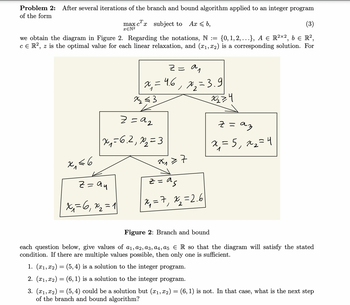
Advanced Engineering Mathematics
10th Edition
ISBN: 9780470458365
Author: Erwin Kreyszig
Publisher: Wiley, John & Sons, Incorporated
expand_more
expand_more
format_list_bulleted
Question

Transcribed Image Text:After several iterations of the branch and bound algorithm applied to an integer program
max cx subject to
Ax≤ b,
(3)
XEN²
we obtain the diagram in Figure 2. Regarding the notations, N := {0, 1, 2,...}, A ɛ R²×², 6 ɛ R²,
CE R², z is the optimal value for each linear relaxation, and (x₁, x2) is a corresponding solution. For
Problem 2:
of the form
x₁≤6
ал
Z=
x₁ = 4.6 x ₁₂ = 3.9
Z=94
x₁ = 6₁ x ₂ = 1
2
x₂2 ≤3
Z=9₂
x₁₂₁= 6.2₁%₂2=3
x₁ = 7
21
>
z=as
x₁ = 7₁ x ₁₂ = 2.6
2
72274
z = 93
x ₁₂ = 5₁ x ₂₁ = 4
Figure 2: Branch and bound
each question below, give values of a₁, a2, a3, a4, a5 € R so that the diagram will satisfy the stated
condition. If there are multiple values possible, then only one is sufficient.
1. (x1, x2) = (5, 4) is a solution to the integer program.
2. (x₁, x₂) = (6, 1) is a solution to the integer program.
3. (x1, x₂) = (5, 4) could be a solution but (x₁, x2) = (6, 1) is not. In that case, what is the next step
of the branch and bound algorithm?
Expert Solution
This question has been solved!
Explore an expertly crafted, step-by-step solution for a thorough understanding of key concepts.
This is a popular solution
Trending nowThis is a popular solution!
Step by stepSolved in 2 steps with 2 images

Knowledge Booster
Similar questions
- Question 7 Classify the nature of this linear program. Assume all the variables are non-negative. Min-2X + Y subject to 3X-Y 22 -X+ 2Y ≤ 10 Y ≤5arrow_forwardCLO3: The following graph represents the growth functions of two different algorithms. Use the graph to answer the questions follow: Function's Growth 140 120 100 80 60 20 1 2 3 4 5 6 7 9 10 11 8 FF-5*x+14 for agor thm B Gx)= x*2 for algorithm A 1) Which algorithm, A or B, performs better when (problem size) n is less than 7? (a 2) Which algorithm, Aor B, performs better when (problem size) n is greater than 7? 3) What can you conclude about the performance of the two algorithms when (problem size) n= 7?arrow_forward1. Solve the following linear programmne using the 2-phase simplex algorithm. You should give the initial tableau and each further tableau produced during the exe- cution of the algorithm. If the program has an optimal solution, give this solution and state its objective value. If it does not have an optimal solution, say why. 2x2x34x4 no need maximize x1- subject to 2x1+x22x3 — x4 ≥ 1, 5x1 x2 x3x4 -1, 2x1 x2 x3 3x4 2, X1, X2, X3, X4 ≥ 0. 2. Apply the first phase of the 2-phase simplex algorithm to the following linear pro- gramme giving the initial tableau and each further tableau produced. Give the starting tableau for the second phase if there is one. maximize 2x1 + x2 + 3x3 x2-x32, subject to x13x2+2x3 ≥ 3, 2x12x2 x3 = 4, X1, X2, X3 0.arrow_forward
- 2. Rewrite the following linear program in standard form. (1) s.t. min z = -5x1 - 6x2 - 7x3 -x1 - 5x2 3x3 ≥ 15 -5x1 - 6x2 + 10x3 ≤ 20 x1x2x3 = -5 x1 ≤ 0, x2 > 0, x3 unconstrained -arrow_forward3.9. Is the reduced echelon form of a matrix unique? Justify your conclusion. Namely, suppose that by performing some row operations (not necessarily fol- lowing any algorithm) we end up with a reduced echelon matrix. Do we always end up with the same matrix, or can we get different ones? Note that we are only allowed to perform row operations, the "column operations"' are forbidden.arrow_forwardplease can you do question 2 aswell. Thank youarrow_forward
arrow_back_ios
arrow_forward_ios
Recommended textbooks for you
 Advanced Engineering MathematicsAdvanced MathISBN:9780470458365Author:Erwin KreyszigPublisher:Wiley, John & Sons, Incorporated
Advanced Engineering MathematicsAdvanced MathISBN:9780470458365Author:Erwin KreyszigPublisher:Wiley, John & Sons, Incorporated Numerical Methods for EngineersAdvanced MathISBN:9780073397924Author:Steven C. Chapra Dr., Raymond P. CanalePublisher:McGraw-Hill Education
Numerical Methods for EngineersAdvanced MathISBN:9780073397924Author:Steven C. Chapra Dr., Raymond P. CanalePublisher:McGraw-Hill Education Introductory Mathematics for Engineering Applicat...Advanced MathISBN:9781118141809Author:Nathan KlingbeilPublisher:WILEY
Introductory Mathematics for Engineering Applicat...Advanced MathISBN:9781118141809Author:Nathan KlingbeilPublisher:WILEY Mathematics For Machine TechnologyAdvanced MathISBN:9781337798310Author:Peterson, John.Publisher:Cengage Learning,
Mathematics For Machine TechnologyAdvanced MathISBN:9781337798310Author:Peterson, John.Publisher:Cengage Learning,


Advanced Engineering Mathematics
Advanced Math
ISBN:9780470458365
Author:Erwin Kreyszig
Publisher:Wiley, John & Sons, Incorporated

Numerical Methods for Engineers
Advanced Math
ISBN:9780073397924
Author:Steven C. Chapra Dr., Raymond P. Canale
Publisher:McGraw-Hill Education

Introductory Mathematics for Engineering Applicat...
Advanced Math
ISBN:9781118141809
Author:Nathan Klingbeil
Publisher:WILEY

Mathematics For Machine Technology
Advanced Math
ISBN:9781337798310
Author:Peterson, John.
Publisher:Cengage Learning,

